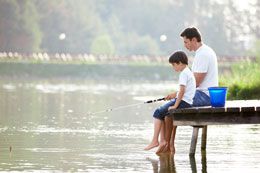Water Safety
 From the National Safety Council
From the National Safety Council
Drowning claims the lives of over 4,000 people every year. Although all age groups are represented, children 0-4 have the highest death rate due to drowning. In 1998, 500 children under the age of five drowned. Most drowning and near-drowning happen when a child falls into a pool or is left alone in the bathtub. The National Safety Council encourages adults to establish and adhere to strict water safety rules.
Safety Tips
- Never leave a child alone near water-at the pool, the beach or in the tub-a tragedy can occur in seconds. If you must leave, take your child with you.
- Always use approved personal floatation devices (life jackets.) The U.S. Coast Guard estimates nearly 9 of 10 drowning victims were not wearing one.
- Beware of neighborhood pools-be it your own or your neighbors. Remove toys from in and around the pool when not in use. Toys can attract children to the pool.
- For pools, barriers can offer added protection against drowning. Power or manual covers will completely cover a pool and block access to the water, however, be sure to drain any standing water from the surface of the pool cover as a child can drown in very small amounts of water.
- Enroll children over age three in swimming lessons taught by qualified instructors. But keep in mind that lessons don’t make your child “drown-proof.”
- Older children risk drowning when they overestimate their swimming ability or underestimate the water depth.
- Teach your children these four key swimming rules:
-
- Always swim with a buddy.
- Don’t dive into unknown bodies of water. Jump feet first to avoid hitting your head on a shallow bottom.
- Don’t push or jump on others.
- Be prepared for an emergency.
- Never consume alcohol when operating a boat.
- Always have a first-aid kit and emergency phone contacts handy. Parents should be trained in CPR.
Help lead Pennsylvania Agriculture
